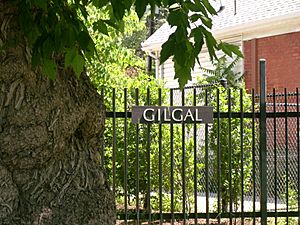Gilgal Sculpture Garden facts for kids
The Gilgal Sculpture Garden is a small public park located in Salt Lake City, Utah, United States. This special park is filled with unusual sculptures that have deep meaning related to Mormonism. One famous sculpture is a Sphinx with the head of Joseph Smith, who founded the church.
A businessman named Thomas Battersby Child, Jr. (1888-1963) designed and built the garden. He worked on it in his free time because he loved it so much. The park has 12 original sculptures and more than 70 stones. These stones are carved with scriptures, poems, and other writings. Gilgal Sculpture Garden is the only place in Utah officially recognized as a "visionary art environment." This means it's a place created by an artist who followed their own unique vision, often without formal training.
Contents
History of the Gilgal Garden
Thomas Child was a builder and a leader in his local church. He dreamed of creating a special sculpture garden. He wanted it to be a peaceful place away from the world. It would also honor his most important religious and personal beliefs.
Child started building the garden in his backyard when he was 57 years old. He spent a lot of his time and money on the project until he passed away in 1963. He named the garden Gilgal after a place in the Bible. In the Bible, Joshua told the Israelites to set up twelve stones there as a memorial. The name "Gilgal" can mean "circle of standing stones," which fits a sculpture garden well. Gilgal is also a name found in The Book of Mormon, a sacred book for members of The Church of Jesus Christ of Latter-day Saints.
Many of the sculptures and quotes in Gilgal Garden relate to themes from the church. These include the restoration of the Priesthood, the journey of Mormon pioneers moving west, and how Child saw similarities between ancient Israelites and his own ancestors.
Thomas Child was not a trained artist. However, he worked very hard to find and shape the perfect stones for his garden. He even set up a full workshop in his yard to cut and finish the stones. He was proud that all the final work on his statues was done right there. He even used unusual tools, like an oxyacetylene torch, which is usually for welding metal. His son-in-law, Bryant Higgs, and Maurice Edmunds Brooks also helped him with the project.
The finished statues are quite unique and unusual. They include a sacrificial altar, a tribute to Child's wife Bertha, and the famous sphinx with the face of Joseph Smith. Child shared his garden with thousands of visitors during his lifetime. He knew that not everyone would understand his artistic ideas. But his main goal was for the garden to make people think. He once said, "You don't have to agree with me. You may think I am a nut, but I hope I have aroused your thinking and curiosity."
Saving and Restoring the Garden
For many years, until 2000, the garden was owned by the Henry P. Fetzer family. Mr. Fetzer was a neighbor who bought the property after Thomas Child died. The garden was only open on Sundays. Sadly, it was often visited and damaged by people trespassing at night. The Fetzer family grew tired of maintaining the garden. They even thought about building apartments on the land. Later, a company from Canada planned to tear down the garden to build condominiums.
But a group of citizens stepped in to save it. They called themselves the Friends of Gilgal Garden. This group was led by Hortense Child Smith, who was the widow of Thomas Child's son. They worked to buy the property. They needed to raise money by January 10, 2000. The group secured $400,000 from Salt Lake County. They also got $100,000 each from The Church of Jesus Christ of Latter-day Saints and the George S. and Dolores Dore Eccles Foundation. These funds covered most of the purchase price.
However, these promises of money depended on the garden becoming a city park. The Salt Lake City Council was hesitant to take it on because of money problems. Eventually, the property was bought for $679,000 and given to the city. On October 21, 2000, Gilgal Garden reopened as a city park. At the opening ceremony, Salt Lake City Mayor Rocky Anderson called the garden "an absolute jewel."
After many years of being neglected and damaged by vandals, the garden has been greatly restored. The Friends of Gilgal Garden now act as the park's caretakers. Many other non-profit groups in Salt Lake City are also helping to raise money to fix the damaged sculptures.
From 2001 to 2005, a group called Utah Master Gardeners worked to remove overgrown weeds. They made the grounds beautiful again. By 2005, work had also begun on restoring some of the sculptures themselves.
Visiting the Gilgal Garden
Gilgal Garden welcomes visitors during these hours:
- April–September: 8 am to 8 pm daily
- October–March: 9 am to 5 pm, if the weather allows
The Garden is closed on Christmas Day, New Year's Day, and Thanksgiving Day.
Images for kids
-
A statue interpretation of King Nebuchadnezzar's dream from the Book of Daniel.
-
This sculpture is inspired by the last chapter of the Book of Ecclesiastes in the Bible. It includes objects from the verse "... the almond tree shall flourish, and the grasshopper shall be a burden... the silver cord be loosed, or the golden bow be broken, or the pitcher be broken at the fountain, or the wheel broken at the eistern."








